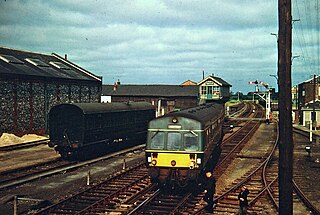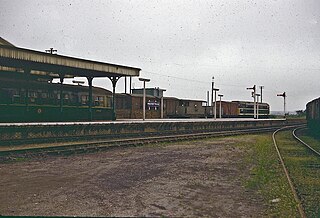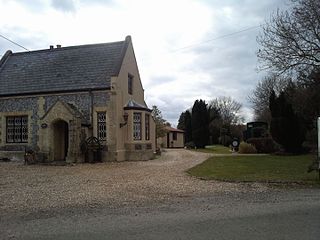
Swaffham is a market town and civil parish in the Breckland District and English county of Norfolk. It is situated 12 miles east of King's Lynn and 31 miles west of Norwich.

The Bure Valley Railway is a 15 in minimum gauge visitors' attraction in Norfolk, England. It was created on the original disused full-gauge bed of a defunct passenger service to incorporate a new, adjacent pedestrian footpath.

Breckland is a local government district in Norfolk, England. Its council is based in Dereham, although the largest town is Thetford. The district also includes the towns of Attleborough, Swaffham and Watton, along with numerous villages and surrounding rural areas.

The Mid-Norfolk Railway (MNR) is a 17+1⁄2 miles (28.2 km) preserved standard gauge heritage railway, one of the longest in Great Britain. Preservation efforts began in 1974, but the line re-opened to passengers only in the mid-1990s as part of the "new generation" of heritage railways. The MNR owns and operates most of the former Wymondham-Fakenham branch line of the Norfolk Railway. The branch opened in 1847, was closed to passengers in stages from 1964 to 1969 as part of the Beeching cuts, and was finally fully closed to goods traffic in 1989.

Watton is a market town in the Breckland district of Norfolk, England, about 25 miles (40 km) west-southwest of Norwich and 15 miles (24 km) northeast of Thetford. The annual Wayland Agricultural Show in its west is one of the oldest one-day such shows in England.

Stow Bedon is a village and former civil parish, now in the parish of Stow Bedon and Breckles, in the Breckland district of the English county of Norfolk. Stow Bedon adjoins the hamlet of Lower Stow Bedon, although the two are often considered to be one village. In the south of the parish is the village of Breckles. In 2011 the merged parish had a population of 290.

Thetford railway station is on the Breckland line in the east of England, serving the market town of Thetford, Norfolk. The line runs between Cambridge in the west and Norwich in the east.

Swaffham railway station was located in Swaffham, Norfolk. It was the junction for lines to King's Lynn, Dereham, and Thetford. The Thetford branch closed on 15 June 1964, and the station closed to passengers on 9 September 1968.

Wells-next-the-Sea was railway station that served the port town of Wells-next-the-Sea in North Norfolk, England. It was opened in 1857 by the Wells & Fakenham Railway, later part of the Great Eastern Railway's Wymondham to Wells branch, and became a junction in 1866 with the arrival of the West Norfolk Junction Railway. It closed in 1964.
Watton railway station was located in Watton, Norfolk. It was on the Great Eastern Railway line between Swaffham and Thetford, and closed for passengers in 1964 and freight in 1965 as part of the Beeching Axe.
Roudham Junction railway station was a station in Norfolk, England. It was located in a remote area east of Thetford, where the Main Line between Norwich and Thetford joined the branch line from Swaffham. Today a few remnants of the former station can be glimpsed from the passing trains.

Wretham and Hockham railway station was a station in Norfolk serving the villages of Wretham and Hockham. It was on the Great Eastern Railway branch line between Swaffham and Thetford. The station was opened for goods traffic on 28 January 1869 and for passengers on 18 October 1869. It closed in 1964.

Great Fransham is a village and former civil parish in the Breckland district, in the county of Norfolk, England, roughly about an equal distance between Swaffham and Dereham. There is also a Little Fransham; the two villages, both now part of the parish of Fransham, were once served by Fransham railway station. In 1931 the parish had a population of 222. On 1 April 1935 the parish was abolished and merged to form Fransham.

Fransham railway station is a former station in Great Fransham, Norfolk. It was opened as part of the Lynn and Dereham Railway, becoming part of the East Anglian Railway from 1847, on the section of line between Dereham and Swaffham.
Ingham railway station was a railway station in Ingham, Suffolk which was located was on the route between Thetford and Bury St Edmunds.

Barnham railway station is a former station in Barnham, Suffolk on a now closed line between Thetford and Bury St Edmunds. It was located close to the Norfolk border.
The Lynn and Dereham Railway was a standard gauge 26+1⁄2-mile (42.6 km) single track railway running between King's Lynn and Dereham in the English county of Norfolk. The Lynn to Dereham line opened in 1846 and closed in 1968, although the section between Middleton Towers and King's Lynn remains open to freight.
The Wymondham to Wells Branch was a railway built in stages by the Norfolk Railway, Eastern Counties Railway and Wells and Fakenham Company between 1847 and 1857. The railway ran from Wymondham in the south, through Dereham and Fakenham to the coastal town of Wells-next-the-Sea; more specifically, the line ran from Wymondham South Junction, where it met the present-day Breckland Line. Passenger services along the line lasted until 1969; the railway continued to be used for freight until 1989. The southern section of the railway now forms the Mid-Norfolk Railway, with part of the northern section serving as the narrow gauge Wells and Walsingham Light Railway.
Loch Neaton is a freshwater lake near Watton in Norfolk, England. It was created after earth was excavated in 1875 to create a mile long embankment for the extension to Swaffham of the Thetford to Watton railway station. Local businessmen saw the potential of creating a leisure park in the area, with a tennis court, bowling green and bandstand. The excavated area was filled with water to create a lake for swimming, boating and fishing.













